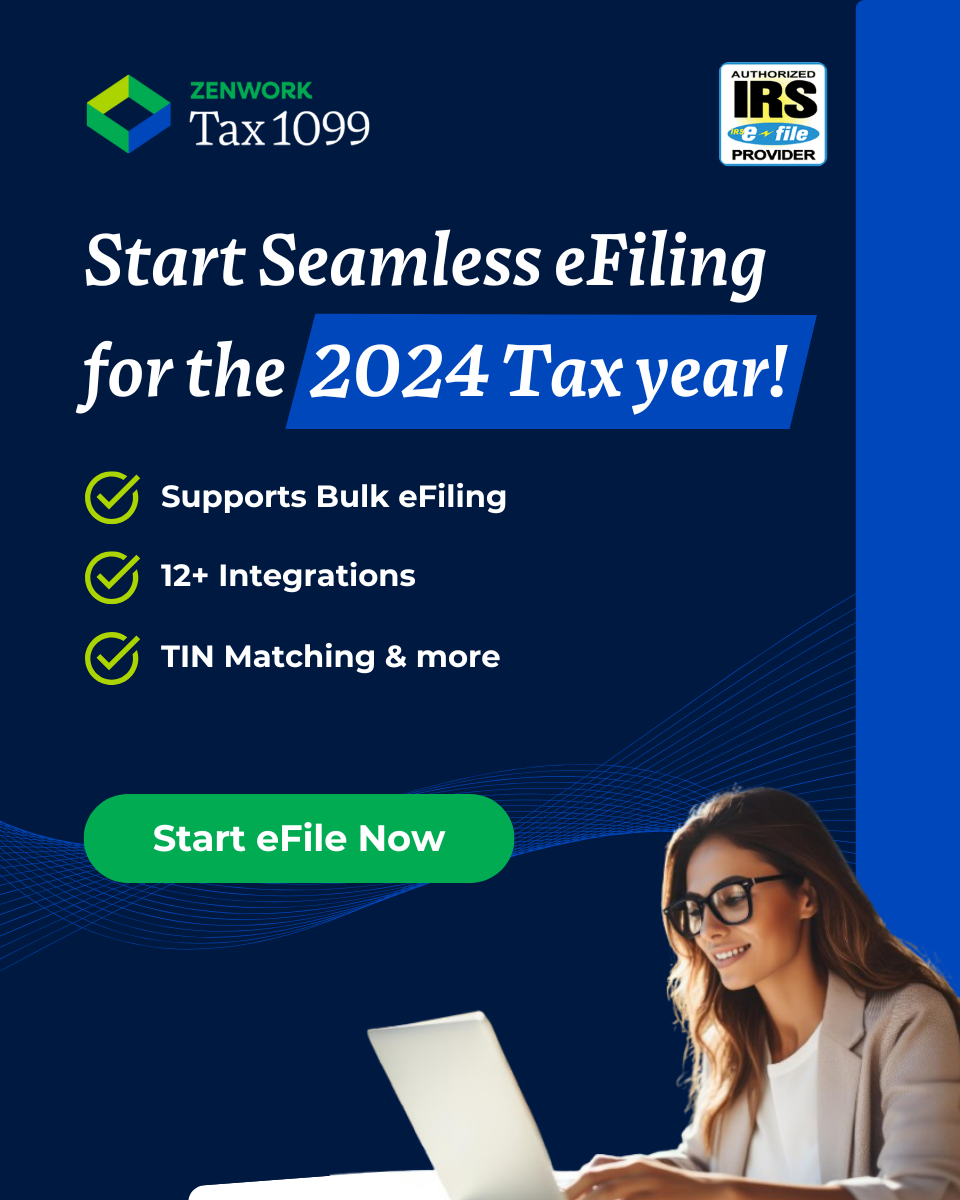Here is a simple guide for the gig economy businesses to understand the state-wise filing requirements for Form 1099-K.
The gig economy is on the rise. With at least 16% of Americans taking up gig work in one way or another, the gig economy is observing an influx of talent pool combined with the business opportunity.
While gig aggregators, such as Fiverr, Upwork, and more are highly dependent on independent vendors, freelancers, and contractors, regulatory reporting issues are also on the radar, citing gaps in compliance.
It is no secret that some gig professionals choose to hide their incomes to reduce the tax burden. The aggregators, however, cannot get away with such tax evasion practices as the cumulative figures of their annual incomes are too huge to ignore.
This is why the IRS requires the gig economy companies to accelerate tax information reporting with voluntary compliance programs.
Hence, the gig economy companies and aggregators are now asking gig professionals within the U.S. to fill out W-9 forms while asking foreign professionals to produce the equivalent. These KYC compliance measures help the gig economy companies weed out the non-compliant profiles and retain verified profiles. The overall practice helps reduce compliance risks and accelerates transparent and accurate reporting.
Form 1099-K reporting instructions were tweaked earlier this year to improve the transparency of reporting. And since 1099-K is a part of the CFSF program, taxpayers can file the form directly with the state.
State filings can be a little confusing at times as the reporting or filing requirements may change for every state. We have put together the necessary information to help you file your 1099-K returns seamlessly so you stay ahead of the curve.
So, let’s get to it.
What Is Form 1099-K?
The IRS requires merchant card payment transactions and third-party network payment transactions to be reported on Form 1099-K if the gross payments exceed $20,000 and the volume of such transactions exceeds 200 for a tax year.
It is essential to note that the transaction threshold of 200 and the reporting payment threshold of $20,000 are only applicable for third-party networks and there is no minimum threshold for payment card transactions.
Form 1099-K plays a huge role in the gig economy because gig employers process the payments to independent contractors through a third-party network or via merchant cards or online wallets. And these transactions must be reported on Form 1099-K.
Useful Links:
Do You Need To File Form 1099-K With Your State?
The following table has been curated to help you understand the filing requirements of each state in a simplified manner. Check it out.
A little heads up before you get to the guide.
Do note that (*) next to the filing requirement specified indicates that the state requires direct filing (even though the form is a part of the CFSF program)
(**) indicates that Form 1099-K must be filed with the state as a part of the CFSF program. Further, if the transaction threshold is lower than the one prescribed by the IRS, you are required to file and report the same directly to the state (if not already submitted to the IRS).
Form 1099-K State Filing Requirements
| STATE | 1099-K FILING REQUIRED? | DIRECT REPORTING REQUIRED? | FILING DUE DATE | FILING THRESHOLD | METHOD OF FILING |
| Alabama | Yes | Yes * | 30 April | Federal thresholds apply | eFile through the state portal. |
| Alaska | No | N/A | N/A | N/A | N/A |
| Arizona | No | N/A | N/A | N/A | N/A |
| Arkansas | Yes | Yes * | 31 January | Federal thresholds apply | Postal mail e-media containing the state file. |
| California | No | N/A | N/A | N/A | N/A |
| Colorado | No | N/A | N/A | N/A | N/A |
| Connecticut | Yes | Yes * | Same as IRS + 30 days | Federal thresholds apply | eFile through the state portal. |
| Delaware | No | N/A | N/A | N/A | N/A |
| District of Columbia | Yes | Yes | 31 January | Federal thresholds apply | eFile through the state portal. |
| Florida | Yes | Yes | IRS deadline + 30 days | Federal thresholds apply | eFile through state portal. |
| Georgia | Yes | Yes * | Same as IRS | Federal thresholds apply | eFile through the state portal. |
| Hawaii | Yes (only if withholding) | Yes | 28 February | Federal thresholds apply | Postal mail 1099 forms. Complete Form N-196 to go along with the 1099 forms. Contact the state department if you have questions or concerns about paper filing. |
| Idaho | Yes (only if withholding) | No ** | 28 February | Federal thresholds apply | File through the CFSF program. Complete Form 967 to go along with the 1099 forms. eFile through the state portal. |
| Illinois | Yes | Yes | Same as IRS | 1,000 USD and 4 transactions | eFile through the state portal. |
| Indiana | Yes (only if withholding) | No ** | 31 January | None (only if amounts withheld) | File through the CFSF program. |
| Iowa | Yes (only if withholding) | Yes (only if withholding) | 15 February | None (only if amounts withheld) | eFile through the state portal. |
| Kansas | Yes | Yes * | 31 January | Federal thresholds apply | eFile through the state portal. |
| Kentucky | Yes (only if withholding) | Yes (only if withholding) | 31 January | None (only if amounts withheld) | Postal mail CD with state file. State ID number is required in the file. |
| Louisiana | No | N/A | N/A | N/A | N/A |
| Maine | No | N/A | N/A | N/A | N/A |
| Maryland | Yes | No ** | 28 February | 600 USD | File through the CFSF program. |
| Massachusetts | Yes | No ** | Same as IRS | 600 USD | File through the CFSF program. You can also eFile through the state portal. |
| Michigan | No | N/A | N/A | N/A | N/A |
| Minnesota | Yes (only if withholding) | Yes (only if withholding) | 31 January | None (only if amounts withheld) | eFile through the state portal. |
| Mississippi | Yes | Yes * | 28 February | 600 USD | eFile through the state portal. |
| Missouri | Yes | Yes (Form 1099-K isn’t accepted through the CFSF program) | 28 February | 1,200 USD | eFile through the state portal. |
| Montana | Yes | No ** | IRS deadline | Federal thresholds apply | File through the CFSF program. If there’s state withholding, you can eFile through the state portal. |
| Nebraska | No | N/A | N/A | N/A | N/A |
| Nevada | No | N/A | N/A | N/A | N/A |
| New Hampshire | No | N/A | N/A | N/A | N/A |
| New Jersey | Yes | No ** | 15 February | 1,000 USD | File through the CFSF program. If there’s state withholding, you can eFile through the state portal. |
| New Mexico | No | N/A | N/A | N/A | N/A |
| New York | Yes | Yes | IRS deadline + 30 days | Federal thresholds apply | eFile through the state portal. |
| North Carolina | Yes | Yes * | IRS deadline | Federal thresholds apply | eFile through the state portal. |
| North Dakota | No | N/A | N/A | N/A | N/A |
| Ohio | No | N/A | N/A | N/A | N/A |
| Oklahoma | No | N/A | N/A | N/A | N/A |
| Oregon | Yes | Yes | IRS deadline | Federal thresholds apply | eFile through the state portal. |
| Pennsylvania | No | N/A | N/A | N/A | N/A |
| Rhode Island | No | N/A | N/A | N/A | N/A |
| South Carolina | No | N/A | N/A | N/A | N/A |
| South Dakota | No | N/A | N/A | N/A | N/A |
| Tennessee | Yes | Yes | IRS deadline + 30 days | Federal thresholds apply | eFile through the state portal. |
| Texas | No | N/A | N/A | N/A | N/A |
| Utah | No | N/A | N/A | N/A | N/A |
| Vermont | Yes | Yes | IRS deadline | 600 USD | eFile through the state portal. State withholding ID number is required in the file. |
| Virginia | Yes | Yes | IRS deadline + 30 days | 600 USD | eFile through the state portal. |
| Washington | No | N/A | N/A | N/A | N/A |
| West Virginia | Yes (only if withholding) | Yes (only if withholding) | 31 January | None (only if amounts withheld) | eFile through the state portal. |
| Wisconsin | No | N/A | N/A | N/A | N/A |
| Wyoming | No | N/A | N/A | N/A | N/A |
How To File Form 1099-K Online With Your State/IRS?
Form 1099-K is a relatively easy form to complete and submit with the state and federal agencies. The only point of conflict for most taxpayers for this tax year is that the state filing requirements have been updated as above. The experts at Tax1099 have devised a simple process to help you prepare, validate, and submit your returns to the IRS and state departments within minutes.
Create your very own, free Tax1099 account to get started. No credit card is required.
- Step 1: Select Form 1099-K from your Tax1099 dashboard
- Step 2: Select State or Fed from the available filing methods.
- Step 3: Import your transaction data from the available integrations
- Step 4: Let Tax1099 comprehend the information and populate the forms appropriately. You can choose to manually enter your data at this stage for a monitored data-entry experience
- Step 5: Validate the reported tax information thoroughly. Use real-time IRS TIN Matching and USPS Address Validation tools from Tax1099 to accelerate reporting accuracy
- Step 6: Submit your returns to the IRS or states successfully within seconds. Download and save the proof of payment instantly.
And that’s it. If you find yourself looking for some quick assistance online for your 1099-K filings, get in touch with our customer success team here and find instant help and resolutions.


